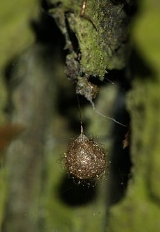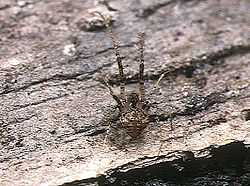
Pirate spider
Encyclopedia

Family (biology)
In biological classification, family is* a taxonomic rank. Other well-known ranks are life, domain, kingdom, phylum, class, order, genus, and species, with family fitting between order and genus. As for the other well-known ranks, there is the option of an immediately lower rank, indicated by the...
Mimetidae, commonly called pirate spiders, are spider
Spider
Spiders are air-breathing arthropods that have eight legs, and chelicerae with fangs that inject venom. They are the largest order of arachnids and rank seventh in total species diversity among all other groups of organisms...
s which typically feed on other spiders.
The family
Family
In human context, a family is a group of people affiliated by consanguinity, affinity, or co-residence. In most societies it is the principal institution for the socialization of children...
Mimetidae contains roughly 200 species
Species
In biology, a species is one of the basic units of biological classification and a taxonomic rank. A species is often defined as a group of organisms capable of interbreeding and producing fertile offspring. While in many cases this definition is adequate, more precise or differing measures are...
divided among 12 genera
Genus
In biology, a genus is a low-level taxonomic rank used in the biological classification of living and fossil organisms, which is an example of definition by genus and differentia...
, of which Mimetus
Mimetus
Mimetus is a genus of pirate spiders in the family Mimetidae. They are found worldwide.-Description:Members of this genus resemble the comb-footed spiders, Theridiidae, due to their globular abdomen. The upper side of this bears curved bristle-like hairs...
and Ero
Ero
Ero is a genus of pirate spiders in the family Mimetidae.-Description:Members of this genus resemble the comb-footed spiders, Theridiidae, due to their globular abdomen which is higher than it is long. The upper side of this bears one or two pairs of conical tubercles and some curved bristle-like...
are the most common. Mimetids are usually yellow and brown and are usually 3 to 7 mm long. Mimetids can be recognized by the rows of spine-like hairs on their long front legs; the rows consist of a long spine, followed by a series of progressively shorter ones.
Mimetidae usually hunt by picking at the strands on their prey's web to simulate the movements of either a trapped insect or a potential mate. When their prey comes to investigate, they are instead captured and eaten. Some mimetids have been observed to feed on insects as well. The spider-feeding habit presents problems in mating, and little is known about how the males court females to avoid being eaten. However, some male mimetids in the genus Gelanor, found in South America, have enormously long appendages which they use to inseminate females.
Taxonomy
The Mimetidae are sometimes taxonomically grouped in the superfamilies AraneoideaAraneoidea
The Araneoidea are a superfamily of araneomorph spiders. They contain families of eight-eyed spiders:* Anapidae* Araneidae* Cyatholipidae* Linyphiidae* Mysmenidae* Nephilidae* Nesticidae* Pimoidae* Sinopimoidae* Symphytognathidae* Synaphridae...
or Palpimanoidea
Palpimanoidea
The Palpimanoidea are a superfamily of eight-eyed spiders, with three containing families:* Huttoniidae* Palpimanidae* StenochilidaeThe Palpimanoidea are the only spider group with no cribellate members....
.
Genera
The categorization into subfamilies follows Joel Hallan's Biology Catalog.- Gelaninae Simon, 1881
- Arochoides Mello-Leitão, 1935 (Brazil)
- Gelanor Thorell, 1869 (Central and South America)
- Melaenosiinae
- Kratochvilia StrandEmbrik StrandEmbrik Strand was an arachnologist who classified many insect and spider species, including the greenbottle blue tarantula....
, 1934 (PrincipePríncipePríncipe is the northern and smaller of the two major islands of the country of São Tomé and Príncipe lying off the west coast of Africa. It has an area of 136 km² and a population of approximately 5,000. The island is a heavily eroded volcano over three million years old, surrounded by other...
) - Melaenosia Simon, 1906 (India)
- Mimetinae Simon, 1881
- Arocha Simon, 1893 (Peru, Brazil)
- Australomimetus Heimer, 1986 (Australia)
- EroEroEro is a genus of pirate spiders in the family Mimetidae.-Description:Members of this genus resemble the comb-footed spiders, Theridiidae, due to their globular abdomen which is higher than it is long. The upper side of this bears one or two pairs of conical tubercles and some curved bristle-like...
C. L. KochCarl Ludwig KochCarl Ludwig Koch was a German entomologist and arachnologist. He was responsible for classifying a great number of spiders, including the Brazilian whiteknee tarantula and Common house spider. He was born in Kusel, Germany and died in Nuremberg, Germany.Carl Ludwig Koch was an inspector of water...
, 1836 (Palearctic, Africa, South America, USA, Asia, Australia) - MimetusMimetusMimetus is a genus of pirate spiders in the family Mimetidae. They are found worldwide.-Description:Members of this genus resemble the comb-footed spiders, Theridiidae, due to their globular abdomen. The upper side of this bears curved bristle-like hairs...
Hentz, 1832 (worldwide) - Phobetinus Simon, 1895 (Vietnam, Sri Lanka)
- Reo Brignoli, 1979 (USA, Kenya)
- Oarcinae Simon, 1890
- Gnolus Simon, 1879 (South America)
- OarcesOarcesOarces is a spider genus in the family Mimetidae. It is the sister genus of Gnolus.-Species:* Oarces ornatus Mello-Leitão, 1935 * Oarces reticulatus -References:...
Simon, 1879 (South America)

